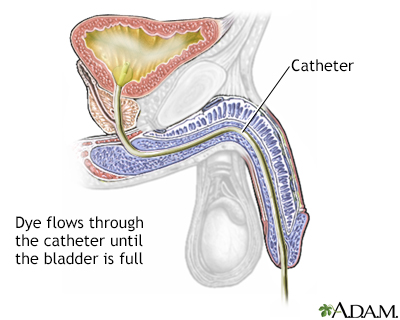Voiding cystourethrogram
A voiding cystourethrogram is an x-ray study of the bladder and urethra. It is done while the bladder is emptying.
x-ray
X-rays are a type of electromagnetic radiation, just like visible light. An x-ray machine sends individual x-ray waves through the body. The images...

How the Test is Performed
The test is performed in a hospital radiology department or in a health care provider's office.
You will lie on your back on the x-ray table. A thin, flexible tube called a catheter will be inserted into the urethra (the tube that carries urine from the bladder to the outside of the body) and passed into the bladder.
Contrast dye flows through the catheter into the bladder. This dye helps the bladder show up better on x-ray images.
The x-rays are taken from various angles while the bladder is full of contrast dye. The catheter is removed so that you can urinate. Images are taken while you empty your bladder.
How to Prepare for the Test
You must sign a consent form. You will be given a gown to wear.
Remove all jewelry before the test. Inform the provider if you are:
- Allergic to any medicines
- Allergic to x-ray contrast material
- Pregnant
How the Test will Feel
You may feel some discomfort when the catheter is placed and while your bladder is full.
Why the Test is Performed
This test may be done to diagnose the cause of urinary tract infections, especially in children who have had more than one urinary tract or bladder infection.
It is also used to diagnose and evaluate:
- Difficulty emptying the bladder
- Birth defects with the bladder or urethra
- Narrowing of the tube that carries urine out of the bladder
(urethral stricture) in males
Urethral stricture
Urethral stricture is an abnormal narrowing of the urethra. The urethra is the tube that carries urine out of the body from the bladder.
 ImageRead Article Now Book Mark Article
ImageRead Article Now Book Mark Article - Urinary reflux from the bladder up into the ureter or kidney
Normal Results
The bladder and urethra will be normal in size and function.
What Abnormal Results Mean
Abnormal results may indicate the following:
- Bladder does not empty properly because of a brain or nerve problem
(neurogenic bladder)
(neurogenic bladder)
Neurogenic bladder is a problem in which a person lacks bladder control due to a brain, spinal cord, or nerve condition.
 ImageRead Article Now Book Mark Article
ImageRead Article Now Book Mark Article - Enlarged prostate gland
Enlarged prostate gland
The prostate is a gland that produces some of the fluid that carries sperm during ejaculation. The prostate gland surrounds the urethra, the tube th...
 ImageRead Article Now Book Mark Article
ImageRead Article Now Book Mark Article - Narrowing or scarring of the urethra
- Pouch-like sacs called diverticula on the walls of the bladder or urethra
Pouch-like sacs
Diverticulosis occurs when small, bulging sacs or pouches form on the inner wall of the intestine. These sacs are called diverticula. Most often, t...
 ImageRead Article Now Book Mark Article
ImageRead Article Now Book Mark Article - Ureterocele
Ureterocele
A ureterocele is a swelling at the bottom of one of the ureters. Ureters are the tubes that carry urine from the kidney to the bladder. The swollen...
 ImageRead Article Now Book Mark Article
ImageRead Article Now Book Mark Article - Urinary reflux nephropathy
Urinary reflux nephropathy
Reflux nephropathy is a condition in which the kidneys are damaged by the backward flow of urine into the kidney.
 ImageRead Article Now Book Mark Article
ImageRead Article Now Book Mark Article
Risks
You may have some discomfort when urinating after this test because of irritation from the catheter.
You may have bladder spasms after this test, which may be a sign of an allergic reaction to the contrast dye. Contact your provider if bothersome bladder spasms occur.
Allergic reaction
Allergic reactions are sensitivities to substances called allergens that come into contact with the skin, nose, eyes, respiratory tract, and gastroin...

You may see blood in your urine for a couple of days after this test.
Reviewed By
Kelly L. Stratton, MD, FACS, Associate Professor, Department of Urology, University of Oklahoma Health Sciences Center, Oklahoma City, OK. Also reviewed by David C. Dugdale, MD, Medical Director, Brenda Conaway, Editorial Director, and the A.D.A.M. Editorial team.
Bishoff JT, Rastinehad AR. Urinary tract imaging: basic principles of CT, MRI, and plain film imaging. In: Partin AW, Dmochowski RR, Kavoussi LR, Peters CA, eds. Campbell-Walsh-Wein Urology. 12th ed. Philadelphia, PA: Elsevier; 2021:chap 3.
Di Carlo HN, Crigger CB. Vesicoureteral reflux. In: Kliegman RM, St. Geme JW, Blum NJ, et al, eds. Nelson Textbook of Pediatrics. 22nd ed. Philadelphia, PA: Elsevier; 2025:chap 576.
Stanasel I, Peters CA. Ectopic ureter, ureterocele, and ureteral anomalies. In: Partin AW, Dmochowski RR, Kavoussi LR, Peters CA, eds. Campbell-Walsh-Wein Urology. 12th ed. Philadelphia, PA: Elsevier; 2021:chap 41.


 All rights reserved.
All rights reserved.